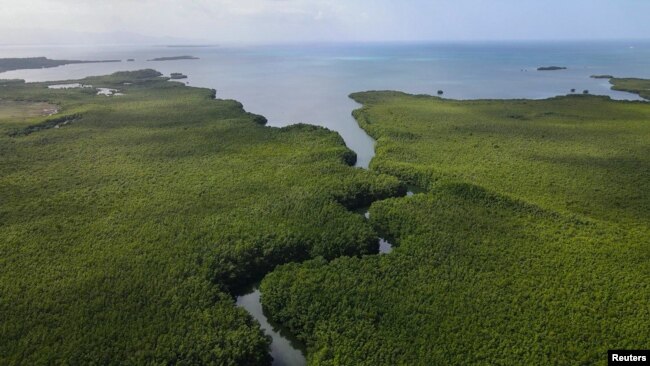Giant bacterium !! Wow!!
定説を覆す、巨大バクテリアが発見されました!!

Map credit:Paris et toi
"Life is fascinating, very diverse and very complex," "It's important to stay curious and have an open mind."
すべてのことに通じる、いい言葉ですね!!
わたしも常にそうありたい!!
VOAで英語を学びましょう!!
世界最大級の細菌を発見(和訳)
Researchers Discover World’s Largest Bacterium
June 28,2022
地球上で最も古い生命体であるバクテリアの可能性について、研究者の考えを変えるような、最大級のバクテリアが発見されました。
この生物はカリブ海のグアドループ島で発見され、人間の目で見ることができるほどの大きさです。
科学者たちは最近、Thiomargarita magnificaティオマルガリータ・マグニフィカと呼ばれるこの細菌は、異常な大きさで--最大で約2センチメートル--だと述べています。また、その構造が他の細菌とは異なっていることも特筆すべき点です。
生物の遺伝情報であるDNAは、他のバクテリアのように細胞内で自由に動き回ることはません。その代わり、DNAは膜に包まれた多くの小さな袋の中に入っています。細胞内の膜に包まれた構造物をオルガネラと呼びます。
この研究はScience⬇️.誌に掲載されたもので、ジャン・マリー・ヴォーランド氏が共同研究者として参加していました。
A bacterium that is not a microbe
A new discovery challenges the prevailing view of the boundaries of bacterial cell sizehttps://www.science.org/doi/10.1126/science.adc9387
ヴォーランド氏はこのバクテリアについて、「通常のサイズのバクテリアの数千倍の大きさです。このバクテリアを発見することは、エベレスト山のように高い人間に遭遇するようなものです。」と語っています。
研究者達は、カリブ海に浮かぶフランスの島々、グアドループの数カ所でこの細菌を発見しています。
研究の共同責任者であるオリビエ・グロ氏は、グアドループ湿地帯の硫黄分を多く含む豊かな海水からこの細菌を初めて発見しました- 湿地帯は一部水に覆われています。
グロ氏は、マングローブの葉に付着している白く長い物質を見つけたのだと説明しました。彼はその物質を研究室に持ち帰って研究しました。
「グアドループのマングローブにこれほど巨大なバクテリアが生息していることに、私は大きな驚きを覚えました。」と彼は話しています。
通常のバクテリアは、1〜5マイクロメートルの大きさです。マイクロメートルは1メートルの100万分の1。この種は平均1万マイクロメートル、1センチメートルです。ティオマルガリータ・マグニフィカはその2倍の長さのものもあります。
ヴォーランド氏は、この細菌が "単一の細菌として考えられる最大の大きさよりも "大きいと述べています。彼は、「まつ毛と同じくらいの大きさと形をしています。」と付け加えています。
これまで知られていた最大のバクテリアは、最大長が約750マイクロメートルでした。
バクテリアは、地球上のほぼ全域に生息する単細胞生物です。細菌は最初の生物と考えられていて、数十億年たった今でも非常に単純な構造を保っています。人間の体内には、たくさんの細菌が存在しています。病気を引き起こすのは、そのうちのごく一部です。
カリブ海のマングローブの沼地は有機物で満たされています。この有機物を微生物が分解して sulfur硫黄を生産します。硫黄が豊富な環境は、ティオマルガリータ・マグニフィカのようなバクテリアにとってエネルギー源となります。
研究チームは、この-細胞器官を保持するDNAを、果物の中の小さな種子を意味するフランス語にちなんで"pepins"”ペパン”と命名しました。
「DNAを膜結合型オルガネラの中に保持する細菌は、2つの例外を除いて他に知られていませんでした。実はこれは、ヒトの細胞や動植物の細胞のように、膜に覆われた核を持つ、より複雑な細胞の特徴なのです。」とヴォーランド氏は語っています。
ゲノム地図を見ると、ティオマルガリータ・マグニフィカはcell division細胞分裂に必要な遺伝子を失っており、細胞を長くするための遺伝子のコピー数が通常より多いことが分かりました。
「また、ゲノムが非常に大きく、通常細菌に見られる平均的な遺伝子数の3倍が含まれています。これらの遺伝子の半分は、何のためにあるのか全くわかっていません。」とヴォーランド氏は言います。
このバクテリアは、地球上の生命がいかにまだ発見を待っている驚きに満ちているかを示している、と彼は言います。
「生命は魅力的で、非常に多様で、非常に複雑なものです。」とヴォーランド氏は付け加えます。「好奇心を持ち続け、オープンマインドでいることが重要なのです。」
Researchers Discover World’s Largest Bacterium
The largest-known bacterium is changing researchers' ideas about what is possible for bacteria, Earth's most ancient life form.
The organism was discovered on the Caribbean island of Guadeloupe and is big enough to be seen with the human eye.
Scientists said recently that the bacterium, called Thiomargarita magnifica, is unusual for its size -- up to about two centimeters long. It is also notable because its structure is unlike other bacteria.
The DNA, an organism's genetic information, is not free-moving inside the cell like in most bacteria. Instead, the DNA is contained within many small membrane-bound sacs. Membrane-bound structures in cells are called organelles.
Jean-Marie Volland was a co-leader of the study that appeared in the publication Science.
Volland said of the bacteria, "It is thousands of times larger than regular-sized bacteria. Discovering this bacterium is like encountering a human being as tall as Mount Everest.”
Researchers have found the bacterium in several places in Guadeloupe, a French island group in the Caribbean.
Study co-leader Olivier Gros first discovered the bacterium in the sulfur-rich seawater of a Guadeloupe swamp - land that is wet and partly covered with water.
Gros described finding long white materials attached to a leaf of a mangrove tree. He brought the materials back to the lab to study.
"Big surprise for me to have so huge a bacterium living in the mangroves of Guadeloupe," he said.
A normal bacteria measures one to five micrometers long. A micrometer is one millionth of a meter. This species averages 10,000 micrometers or one cm long. Some Thiomargarita magnifica are double that length.
Volland said the bacterium is bigger “than what we thought was the maximum possible size for a single bacterium." He added, "They are about the same size and shape of an eyelash."
The largest-known bacterium until now had a maximum length of around 750 micrometers.
Bacteria are single-celled organisms that live nearly everywhere on Earth. Bacteria are thought to have been the first organisms and remain very simple in structure billions of years later. The bodies of humans are filled with bacteria. Only a small number of these cause disease.
Caribbean mangrove swamps are filled with organic material. Microbes break down this material and produce sulfur. The sulfur-rich environment offers an energy source for bacteria like Thiomargarita magnifica.
The researchers named its DNA-holding organelles "pepins" after a French word for small seeds inside fruits.
"Aside from two exceptions, there were no other bacteria known to keep their DNA inside a membrane-bound organelle. That is, in fact, a characteristic of more complex cells which have a membrane-bound nucleus, such as human cells, or animal and plant cells," Volland said.
A genome map showed that Thiomargarita magnifica has lost some genes needed for cell division and has more than the usual number of copies of genes responsible for cell lengthening.
"The genome is also very big and contains three times the average number of genes that are usually found in bacteria. Half of those genes, we have no idea what are they for," Volland said.
This bacterium shows how life on Earth still has surprises awaiting discovery, he said.
"Life is fascinating, very diverse and very complex," Volland added. "It's important to stay curious and have an open mind."

